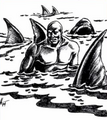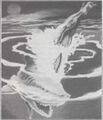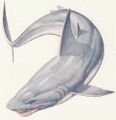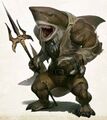Wereshark
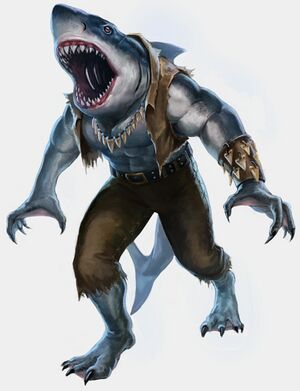
Weresharks are, obviously, a breed of therianthrope where you have a human who turns into a shark. Despite the general lack of popularity of aquatic adventurers and monsters, they've got a long appearance in Dungeons & Dragons (with inevitable Pathfinder counterparts), and even Werewolf: The Apocalypse has them.
D&D[edit | edit source]
Weresharks have been a part of Dungeons & Dragons for a fair while, and are considered a "generic" therianthrope, with noted presence in both the Forgotten Realms and Ravenloft.
In 2nd edition generic lore, weresharks are described as brutish, cruel and arrogant aquatic therianthropes that can assume the form of 20' long great white sharks. Usually human men in their base form (because human men tend to be the ones who fish and sail, and thus put themselves at risk of being attacked by these beasts), a wereshark's humanoid form is often hideously scarred or maimed due to the devastating effects of a shark bite, but its shark form is unblemished even if their humanoid form has lost limbs. Selfish and individualistic, they are also fiercely territorial, staking claims on sunken ships or undersea caves and defending them to the death. They often plunder these areas so they can use the treasures found for their own gain above the waves. Typically, a wereshark is only found accompanied by a school of normal sharks, and these sadistic brutes enjoy wounding foes to provoke a feeding frenzy in their "entourage", sitting back and watching as their prey is torn apart before scavenging for any loot that might have been left over. When they do attack directly, they prefer to go for the legs, or simply swallow their prey whole - their bite attack does 5d4 damage and lets them automatically swallow man-sized or smaller creatures if the wereshark's attack roll beats the victim's THAC0 by 5+. They may sometimes ally with other weresharks, priests of evil sea gods, or the sahuagin, but ultimately they are usually too individualistic to be found in numbers.
Talking of sahuagin, that same 2e generic lore notes that "there are also persistent rumors among the sea-dwellers of sahuagin weresharks that are treated as holy warriors and a larger than any known human weresharks (12 Hit Dice)". The splatbook "Monstrous Arcana: The Sea Devils" goes into detail about sahuagin weresharks and establishs two things.
Firstly, wereshark therianthropy is highly respected amongst sahuagin, and a sahuagin wereshark can expect a considerable promotion in social status (though females who become infected are prohibited from breeding, for some reason). In contrast, on the rare occasions that a sahuagin contracts seawolf strain therianthropy, they are forced to flee for their lives. Both forms of therianthropy are highly incompatible with sahuagin biology; sahuagin weresharks die within 200 years of contracting the disease, which admittedly is better than the 75 years to live that a sahuagin seawolf gets.
Secondly, sahuagin will go out of their way to c apture non-sahuagin weresharks alive and use them as elite combatants in their gladiatorial arena. If a wereshark survives in the arena for 3 years, they are considered blessed by Sekolah and officially adopted into the community, though they are treated more like a favored pet than an equal.
"The Sea Devils" also establishes that the wereshark has a "sharkwere" antithesis, like the werewolf and the wolfwere. Known as the nawidnehr, this creature is bigger, fiercer and nastier than the wereshark, and the two absolutely hate each other, fighting to the death on sight.
Pathfinder[edit | edit source]
Appear in Pathfinder, and even have a skinwalker lineage related to them.
World of Darkness[edit | edit source]
They're called Rokea and are almost always born to female sharks, generally having very little to do with the human world.
Gallery[edit | edit source]
-
1e
-
2e
-
Pathfinder
| The Therianthropes of Dungeons & Dragons | |
|---|---|
| Therianthrope | Laridian • Loup-garou • Loup du Noir • Lythari • Red Falcon • Seawolf • Selkie • Shifter • Swanmay • Thebestyn • Vodoni • Werebaboon • Werebadger • Werebat • Werebear • Wereboar • Werecat • Werecrocodile • Werefox • Werehyena • Werejackal • Werejaguar • Werekillerwhale • Wereleopard • Werelion • Werepanther • Wererat • Wereraven • Wereray • Wereseal • Weresnake • Wereshark • Werespider • Wereswine • Weretiger • Werewalrus • Werewolf |
| Antherions | Aranea • Song Dragon • Jackalwere • Nawidnehr • Wolfwere |
| Third Party | Werealligator • Wereanaconda • Werebunny • Werecheetah • Werecobra • Weremustela • Wereoctopus • Werepossum • Wereraccoon • Werestag • Werewolverine |

